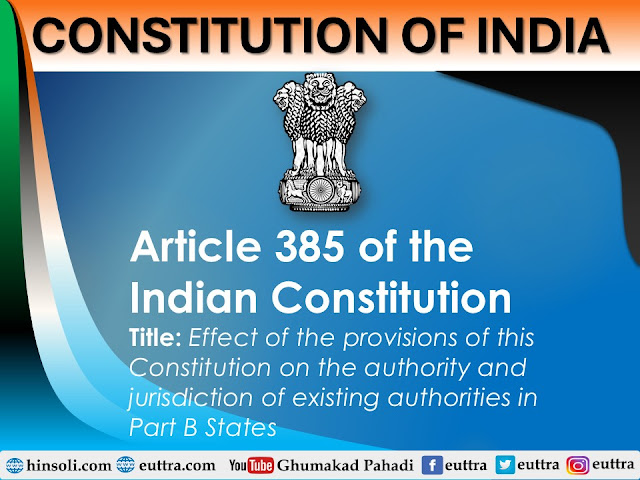 |
| What is Article 385 of Indian constitution |
Article 385 of the Indian Constitution
Title: Effect of the provisions of this Constitution on the authority and jurisdiction of existing authorities in Part B States
❗️Status:
Article 385 has been repealed by the 7th Constitutional Amendment Act, 1956.
🧾 Original Purpose (Before Repeal):
-
Article 385 addressed the legal status and functioning of existing authorities (executive, legislative, judicial) in Part B States when the Constitution of India came into force on 26 January 1950.
-
It ensured that these authorities continued to operate, but now subject to the Constitution.
🔍 Simplified Explanation:
-
Before 1950, Part B States (former princely states) had their own governments, laws, and institutions.
-
Article 385 ensured that:
-
These existing authorities did not become invalid just because the Constitution came into force.
-
But all such bodies would now function only as per the Indian Constitution.
-
Their powers and functions were limited to what the Constitution permitted.
-
📌 Key Features:
| Aspect | Details |
|---|---|
| Applies To | Authorities in Part B States (executive, legislature, judiciary, etc.) |
| Provision | Allowed them to continue functioning after 26 Jan 1950 |
| Condition | Must now act within the framework of the Constitution |
| Goal | To ensure administrative and legal continuity while shifting to constitutional rule |
| Repealed By | 7th Constitutional Amendment Act, 1956 |
🗂️ Background – Part B States Included:
-
Hyderabad
-
Jammu & Kashmir (partially autonomous under Article 370)
-
Mysore
-
Madhya Bharat
-
Travancore-Cochin
-
Rajasthan
-
Saurashtra
-
PEPSU (Patiala & East Punjab States Union)
✅ Why Article 385 Was Important (and Then Repealed):
-
Prevented governance breakdown in Part B states during transition.
-
Ensured existing institutions remained active but within constitutional limits.
-
Became obsolete after 1956, when Part A, B, C classification was removed, and all states were brought under a uniform constitutional structure.
Here is a comparison of Articles 380 to 385 of the Indian Constitution — all of which were transitional provisions specifically designed for Part B States (former princely states) and were repealed by the 7th Constitutional Amendment Act, 1956.
🆚 Comparison Table: Articles 380 to 385
| Article | Subject | Purpose | Who/What It Applied To | Ends When | Repealed By |
|---|---|---|---|---|---|
| 380 | Constitution of Legislatures in Part B States | Allowed temporary legislative bodies in Part B States | Legislatures in princely states | Upon formation of elected state legislatures | 7th Amendment Act, 1956 |
| 381 | Governor of Part B States | Allowed Rajpramukhs to serve as Governors temporarily | Rajpramukhs (heads of princely states) | Upon appointment of Governors under Article 155 | 7th Amendment Act, 1956 |
| 382 | Council of Ministers in Part B States | Allowed existing ministers to continue temporarily | Ministers in princely states | Until formation of new Council of Ministers | 7th Amendment Act, 1956 |
| 383 | Governor’s legislative powers in absence of legislature | Allowed Governor to exercise legislative power until legislature formed | Governor of Part B States | Upon establishment of state legislatures | 7th Amendment Act, 1956 |
| 384 | Adaptation of existing laws in Part B States | Permitted continuation and adaptation of pre-existing laws | Laws of princely states | When laws were adapted/replaced under Constitution | 7th Amendment Act, 1956 |
| 385 | Existing authorities in Part B States | Ensured existing authorities continue, but subject to the Constitution | Administrative, judicial & legislative bodies in Part B States | When constitutional institutions replaced existing ones | 7th Amendment Act, 1956 |
🧾 Key Takeaways:
-
These articles ensured smooth integration of princely states (Part B) into the Indian Union after 1950.
-
They covered legislatures, governors, ministers, laws, and authorities.
-
All were temporary, designed to avoid administrative or legal vacuum.
-
Repealed in 1956 when India adopted a uniform state structure through the States Reorganisation Act.

.jpg)


















Follow Us